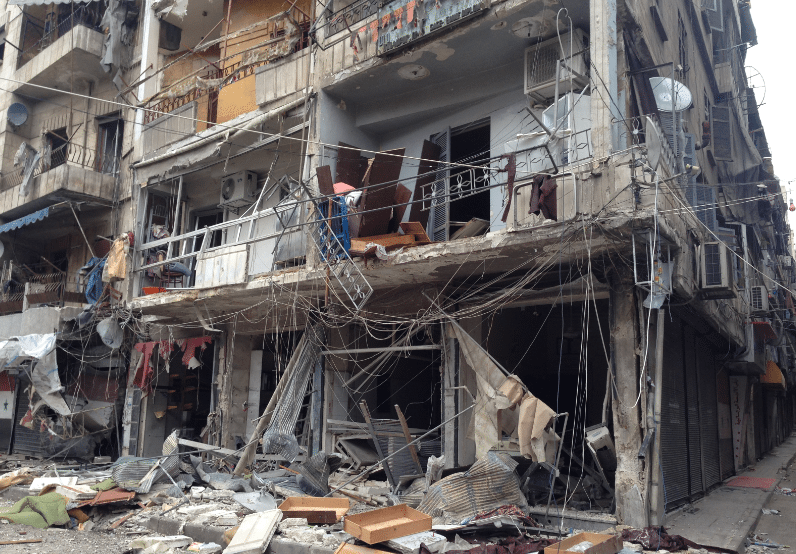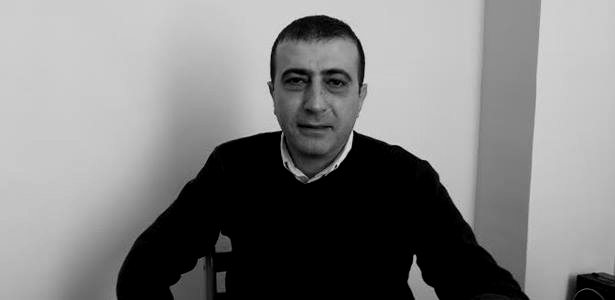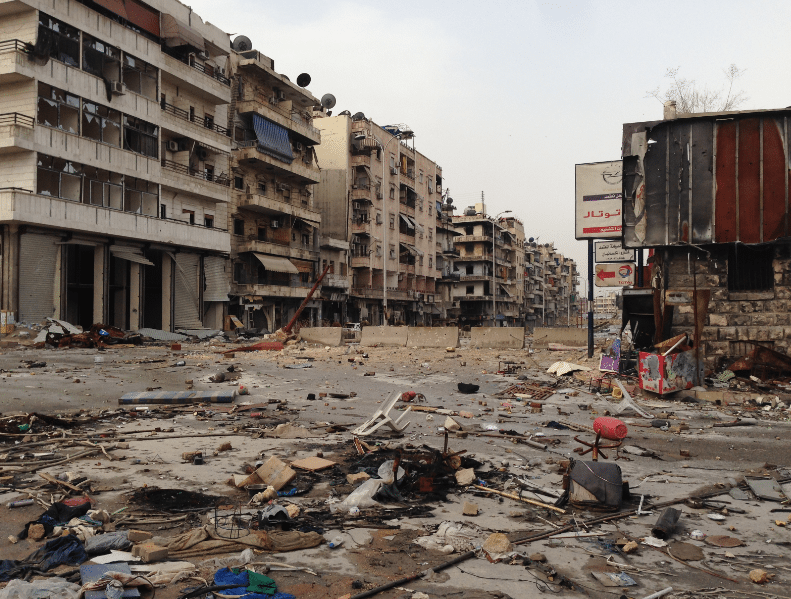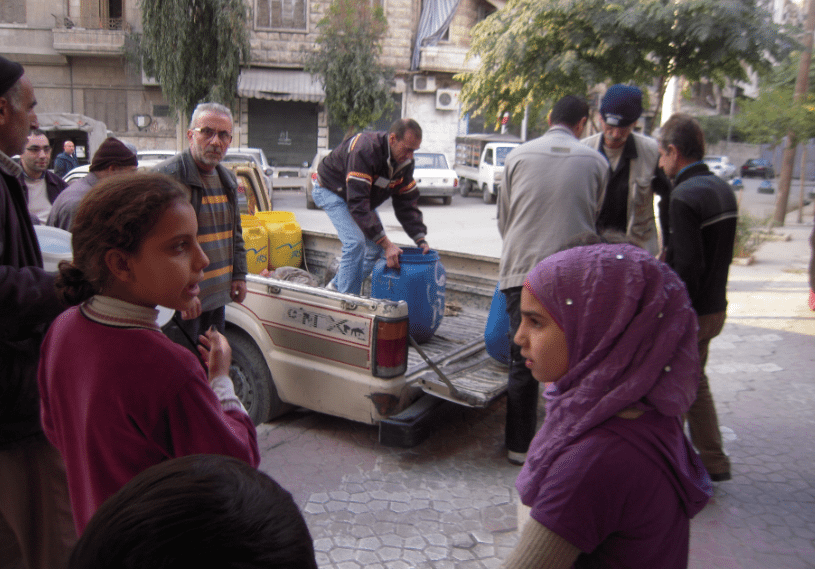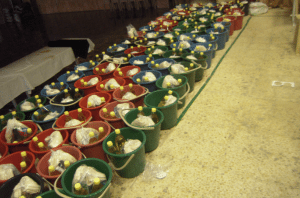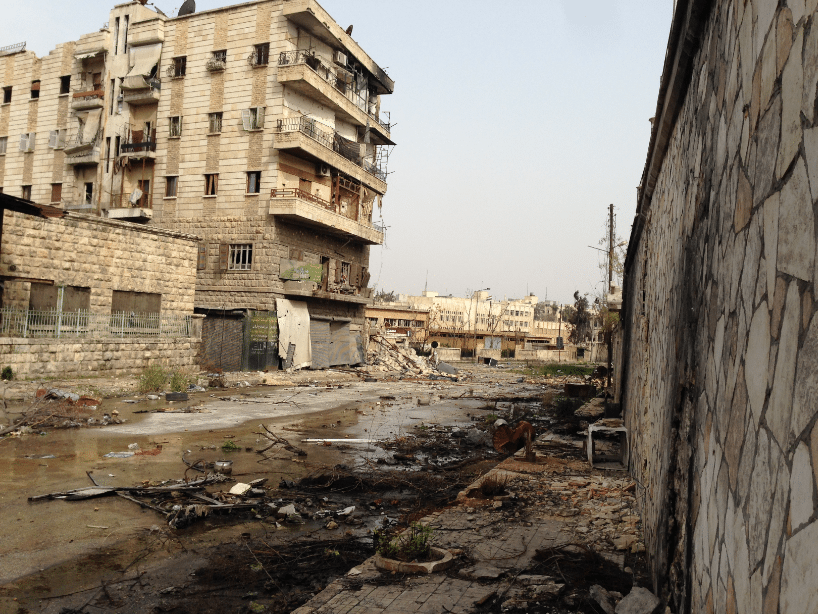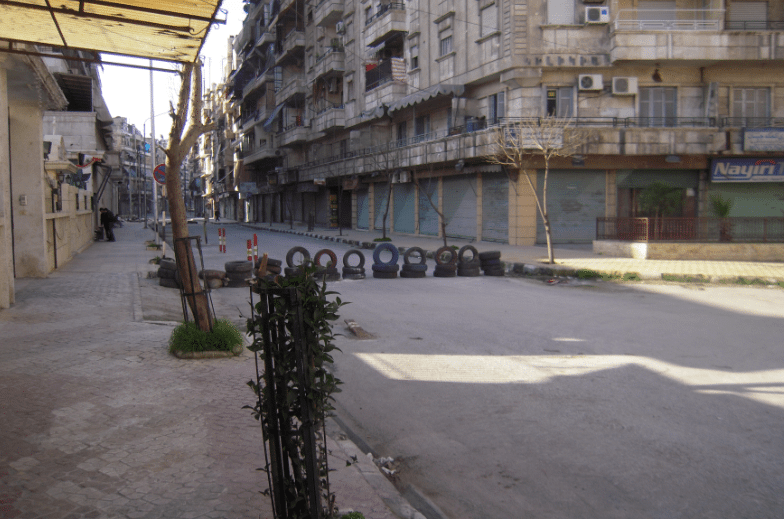Surviving Aleppo: An Interview with Nerses Sarkissian

WATERTOWN, Mass. (A.W.)—As the Syrian Civil War approaches its five-year mark, the historic Armenian community of Syria continues to be caught in the ongoing conflict. Yet, Armenians have found a way to continue their everyday life in Syria—with minor adjustments, of course. “We weren’t the cause of this war, but unfortunately we are caught in the crossfire,” said Dr. Nerses Sarkissian, only three days after getting to the United States from the war-stricken country.
A scene from the destruction in Aleppo
Sarkissian, a member of the Armenian Revolutionary Federation (ARF) Central Committee of Syria and of the Syrian Armenian Committee for Urgent Relief and Rehabilitation, is touring Armenian communities across the Eastern United States from Dec. 1-24 to present the current situation in Syria and the challenges facing the Armenian community there. The tour is being organized by the ARF Central Committee of the Eastern United States and the Armenian Relief Society (ARS) Eastern United States.
“Today, five years after the beginning of the war, the Armenian community of Syria, with all of its organizations, religious and educational institutions and cultural societies, continues to function properly and completely,” he said. “Events continue to take place. Just next month, one of the Armenian choirs will give a big performance with a new repertoire of songs.”
However, it has been all but easy for Syrian Armenians, who number around 35,000, according to Sarkissian. Ongoing challenges including a lack of water and electricity, a depleted economy, joblessness, and constant threats of rocket attacks and escalated violence.
The Armenians of Syria are resolute, and have vowed to endure. “However difficult the situation is for the people, the Armenian community remains determined to stay and to survive,” he explained.
The first event featuring Sarkissian took place at Worcester State University on Dec. 1, at a symposium on refugees organized by the university’s Center for the Study of Human Rights. There, he spoke in detail about the safety of the Syrian-Armenian community, the economic and day-to-day hardships they face, the state of the Armenian educational system in the country, and the political situation in areas populated by Armenians. Since then, he has spoken at events in Detroit and New York.
Sarkissian’s speaking tour will continue in the coming weeks with events in Boston (Dec. 10), Providence (Dec. 11), Washington, D.C. (Dec. 12), Chicago (Dec. 13), Granite City (Dec. 14), Philadelphia (Dec. 18), and New Jersey (Dec. 19).
Below is the Armenian Weekly’s interview with Dr. Nerses Sarkissian in its entirety.
Dr. Nerses Sarkissian
***
Rupen Janbazian—What can you tell our readers about the current situation in Syria’s Armenian-populated areas? What is the current condition of the Syrian-Armenian community?
Nerses Sarkissian—It’s difficult to explain the current condition of the Syrian-Armenian community without providing some background on the socio-political situation of Syria today. Over the past few months, the political situation in the country has been a little more hopeful than it was earlier. The rise of terror in the country has now become troubling for the world, not only for those within Syria. Although the threat of terrorism has been of great concern for all, not all countries have responded in the same manner. Certain countries, such as Russia, are steadfastly determined to rid Syria of terrorists. However, many other countries approach this threat with much more caution, for various political reasons and gains.
In general, it is clear that the Syrian conflict, along with the rising threat of terrorism in the country, will eventually be resolved through a political process. This process may take a long time, or it may not; we don’t know exactly. The Syrian conflict has now become an international issue of a balance of power in the Middle East. It has transformed from a local issue to a regional issue, and now has become an international one.
An Aleppo street in ruins
If we place the issue of Syrian Armenians in the larger context of the Syrian conflict, we cannot say that the situations in all Armenian communities throughout the country are the same—each one is unique, both geographically and demographically. Aleppo is considered the heart of the Syrian-Armenian community; all of the central offices of our organizations, the Prelacy of the Armenian Church, they are all based in Aleppo.
Aleppo is split into two main parts: One part is under the control of the opposition, and the other is under the control of the government. Unfortunately, the two parts are separated by districts that are heavily populated by Armenians, such as Nor Kyugh. That “border” has not changed since 2012. While there have been several attempts to penetrate, the boundaries have remained unchanged since the beginning of the war.
In terms of the Aleppo province as a whole, the government has made some substantial advancements there. They have used certain tactics by surrounding cities and attempting to join them to other cities through a safe corridor. Russia’s recent involvement has greatly helped this effort. We [Syrian-Armenians] believe that if the conflict continues as such, and is not affected by other external forces, the Armenians in the region can be in a safer situation. Unfortunately, the community is not safe today, since dangerous battles continue throughout Aleppo and in various parts of the province.
Wars usually lead to many forms of exploitation. This has also been the case in Syria, where people’s basic needs are constantly taken advantage of. For example, the company responsible for the distribution of Aleppo’s water happens to be in that part of the city that is under the control of the opposition—an opposition that, for the most part, is comprised of members of various terrorist organizations. Often times, those in charge of such resources will have various demands before distributing essential things like water to peaceful citizens For example, they will demand such things as the freeing of prisoners, or bribes. As a result of this situation, there can be many months during which the city has no water.
Electricity has been almost non-existent in Aleppo for the past two months. The residents of the city rely on expensive generators to have power, which do not necessarily satisfy the needs of the people. Other major necessities, such as food and bread, exist in the country. However, when the main corridor into the city is closed off, even food becomes scarce and expensive. Taking all of this into account, it is also important to note that the people of Syria have greatly suffered economically; unemployment has become prevalent as a result of the war.
Perhaps most importantly, though, is the fact that our safety is in danger every day.
R.J.—How has the Syrian-Armenian community been able to face and overcome these many challenges, especially the fact that people’s lives are in danger?
N.S.—All of Aleppo has become a target, not only the Armenian districts. However, sometimes the Armenian-populated districts are more of a target than other parts of the city, since there are factions within the opposition that have an anti-Armenian, or pro-Turkish, agenda. So the safety of our community is always in danger.
However, we somehow always find a way to face and overcome these challenges. For example, the issue of water. The government and some benevolent organizations have dug wells on the property of some churches and mosques. Members of the Armenian community distribute the water from these wells to the greater community using special water-transporting vehicles. Water is distributed to whoever is in need of water and does not have access to a reservoir, either at cost price or no cost at all, depending on if they can afford it or not.
Water is distributed to whoever is in need of water and does not have access to a reservoir
Another example of how the community faces these challenges is the distribution of financial aid. The donations that have been coming in from across the world get distributed to the neediest of families within the community, for things like fuel in the winter months. In terms of electricity, the community owns a large generator in the Nor Kyugh district that distributes power to the entire area. This was the first time a community had done this Aleppo.
Since the Syrian economy lies in ruins and the country is faced with constant threats, none of this would be possible without the financial contribution of the worldwide Armenian Diaspora.
The [Armenian] school system has been functioning very normally. Certain adjustments had to be made, but we are happy to say that the war has not interfered with our children’s education. All of the Armenian Prelacy schools currently function under one roof, and the other Armenian community schools continue to function properly. This is the case for Aleppo.
R.J.—What about the other cities with Armenian populations?
N.S.—In terms of the other cities in Syria with significant Armenian populations, they are in a much better position than Aleppo, which is likely in the worst situation. If I were to rank the situations in the cities from most dangerous to least dangerous, it would be Aleppo, Damascus, Kamishli, Kessab, and Latakia.
Since the city of Latakia is the safest, there has been substantial internal migration there from other regions. Many people from Aleppo and Kamishli—including a large number of Armenians—have relocated to Latakia during the war for safe refuge.
The Armenian community continues to do its part in helping out the people every day. We do this by distributing financial aid and services to those in need, but also by always standing guard in areas heavily populated by Armenians, in order to ensure their safety. We try to make conditions such that our people can survive.
Of course, it is impossible to guarantee the safety of everyone—there is constant bombing that we have no control over. However, we do our best when it comes to things like instances of penetration into Armenian districts by others. For example, in the case of Aleppo, we have set up 3 headquarters, from which members of the community conduct 24-hour mounted guard of the Armenian areas, in order to maintain the peace there, to prevent things like attacks and lootings.
The Armenian community continues to do its part in helping out the people every day
This has been very important for the morale of members of the community. When they see that the Armenian youth, who are sometimes armed, are ever-present and are there to protect their safety—not to participate in the war, but to defend the Armenian community—the people feel safe. Even when there are rocket attacks, our volunteers help to avoid panic from taking over the community. In times of crisis, the volunteers help distribute food, water, and other basic needs, and help people move to safer spaces. All of this is done systematically and in a highly organized fashion.
It’s a system that works around the clock—24 hours a day—without rest. Volunteers range from 18-50 years old. Armenians may not be taking part in the fighting, but we are ready to defend our community if attacked. The Armenian communities of Kessab and Kamishli have employed similar systems of volunteer guards, though it is much safer than Aleppo.
There used to be other cities with significant Armenian populations, but as a result of the war, the Armenians of cities such as Raqqa, Tal Abyad, Hasakeh, and Taccoubia are now completely gone. These cities are now devoid of their Armenian populations. Unfortunately, these are areas that were subjected to ethnic cleansing—Armenians and other Christians were all driven out of these areas by radical Islamists who took over those parts of the country. These include ISIS and al-Nursa militants.
R.J.—What is the total number of Armenians still living in the country?
N.S.—Prior to the war, in 2010, approximately 80,000 Armenians lived throughout Syria. Today, the Armenian population has decreased to about 35,000. Aleppo continues to house the biggest Armenian community in the country. Prior to the war, about 40,000 Armenians lived there, whereas today, around 12,000-15,000 remain. Damascus’s Armenian population has dropped from 10,000 to 8,000. Kamishli was once 10,000, and now has 5,000 Armenians. Kessab was about 2,000 and now has 1,500. Interestingly, Latakia’s Armenian population has actually increased from 5,000 to approximately 7,000 due to internal migration.
Unfortunately, the community is not safe today, since dangerous battles continue throughout Aleppo and in various parts of the province
Many population figures have been claimed by various people, but we must approach the issue in a logical manner. It is difficult to conduct a proper census, for obvious reasons, but if we were to base the total number of Armenians on figures we are sure about, we can know how many still remain. In the case of Aleppo, there are over 3,500 students registered at the Armenian schools in the city. If we were to multiply that figure by 3 or 4, in order to get a sense of the total Armenian population in Aleppo, it would mean that there are up to 15,000 still living in the city. We shouldn’t succumb to pessimism, nor should we invent optimistic figures. Population numbers must be based on facts.
If the war were to end, or turn into a manageable conflict with a peace process in place, we believe that a large number of those who had fled would return to Syria, and the community would return to its normal state. We have not yet received a blow hard enough that has paralyzed our community. We haven’t reached that point. All facets of community life function properly; they may function on a smaller scale at times, but they still continue to exist and function.
This war will not end overnight, but it must eventually move towards peace.
R.J.—How have the relations been between the Syrian-Armenian community and other Syrian communities?
N.S.—We have continued to establish and maintain well-balanced and constructive relationships with many different communities in the country—communities from both sides of the conflict, who are truly Syrian and want a better future for the country. We only discriminate against terrorists and those who wish to harm the people of Syria.
R.J.—The conflict in Syria is ever-changing, with new players entering the warzone and international pressure for an end to the war. How do you view Russia’s involvement in Syria?
N.S.—We view Russia’s involvement in Syria, based on what they have announced and the steps they have taken there, as a positive initiative aimed at defeating terrorism, while putting forward a political process for peace. We believe this is the right approach. Terrorism should not be condoned or used as a political tool. Terrorism must be defeated.
Terrorism not only threatens Syria, but the entire world. We have seen acts of terror take place throughout the Middle East, in Europe, and even in North America, in recent days. Terrorism knows no borders and must be crushed completely and absolutely. If not stopped, then the world will face many repercussions and consequences.
R.J.—What do you see as the future for Syrian-Armenians? Does the community have a future in Syria?
N.S.—Throughout the history of the Armenian people, there have been countless instances where the odds have been against us. At times, Armenians have been quick to retreat and surrender. This is not the case for the Armenians of Aleppo and Syria. However big the influx of emigration from the country may be; however difficult the situation is for the people; the Armenian community remains determined to stay and to survive. In Syria, not only do Armenians exist, but Armenianness exists—until today. I believe that the Armenian people of Syria are ready to preserve their community until it is no longer humanly possible to survive there.
You may ask what the reason for this is. This is not necessarily an issue of mentality. The reason for this determination is the history of the Syrian-Armenian community, which was created immediately following the Armenian Genocide—it has deep reaching roots. Syria became the first site of resurrection for the Armenian people after the genocide. There is truly a sense of Syria being a homeland for the Armenian people. Armenia is and continues to be our homeland, yes, but we have also spilled blood, worked tirelessly, and resurrected as a people in this country. There is absolutely no sense of giving up quickly and running away.
We consider the emigration of Armenians from Syria a natural phenomenon, due to the war. However, we don’t foresee the entire community to leave the country at any time. We hope to do our best in maintaining our potential strength—or at least, to not lose it completely. We have had several conversations with authorities in Armenia to develop an environment there, which will help assure that the Syrian-Armenians who move there will stay and not immigrate to other countries. There are other examples of countries such as Canada, which create special circumstances that facilitate immigration there. We were not opposed if our community members decided to emigrate. In fact, we try our best to facilitate it if they decided to, by initiating contact with the Armenian communities in those respective cities, in order to ensure that integration into those communities is as seamless as possible. It all goes back to lot losing our potential strength. Even in the grim situation we find ourselves in today, even if some members of the community are going to move to other countries and other communities, it is important for us all to stick together, and for us to do our best to preserve what we have.
Ongoing challenges including a lack of water and electricity, a depleted economy, joblessness, and constant threats of rocket attacks and escalated violence
This war was an inevitable evil—we weren’t the cause of this war, but unfortunately we are caught in the crossfire. If we are able to preserve our community, and ensure that those Armenians who have left Syria maintain their cultural and national identity, our losses will be kept to a minimum.
Today, five years after the beginning of the war, the Armenian community of Syria, with all of its organizations, religious and educational institutions and cultural societies, continue to function properly and completely. Events continue to take place. Just next month, one of the Armenian choirs will give a big performance with a new repertoire of songs. We will soon celebrate the 125thanniversary of the ARF in Aleppo with performers and guest speakers from abroad. Life has been going on as usual. It’s been tough, yes, but that doesn’t mean we should just pick up and leave our homes.
People say we should run away. Run away until when? Our determination to survive speaks to the determination of the Armenian people; the determination to maintain faith and not to give up easily. We are not throwing in the towel just yet. There is a large number of Armenian youth in Syria today that is resolute in not surrendering.
We are hopeful that this war, like all other wars, will find its end. Today, the Armenian community is even prepared to take part in any political process that may come about in Syria, which looks for a lasting peace. Whether that is a new constitution, a new system of government, or whatever that may look like—we Armenians will take part in the process.




 Արևելահայերեն
Արևելահայերեն Արևմտահայերեն
Արևմտահայերեն Русский
Русский